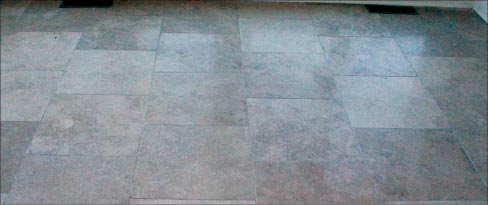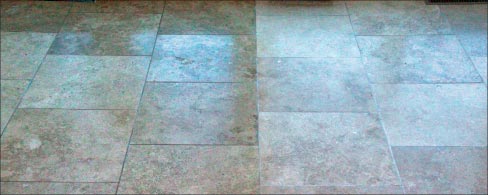Restoration & Maintenance Corner: Travertine and Similar Stone
Bob Murrell
Stone Restoration
Photos provided by Bob Murrell
Mouse over photos for caption
 Travertine is a type of limestone formed under very different conditions than most other limestones. Typical limestones are formed from calcareous organic sea creatures which settle on the bottom and are cemented together by pressure, over time, and even recrystallized later.
Travertine is a type of limestone formed under very different conditions than most other limestones. Typical limestones are formed from calcareous organic sea creatures which settle on the bottom and are cemented together by pressure, over time, and even recrystallized later.
 Travertine is a sedimentary rock typically formed on land around the mouth or conduits of hot springs or volcanic activity fractures. Warm or hot fresh water laden with minerals precipitates calcium carbonate buildup forming the travertine. Think of the mud pots in Yellowstone National Park.
Travertine is a sedimentary rock typically formed on land around the mouth or conduits of hot springs or volcanic activity fractures. Warm or hot fresh water laden with minerals precipitates calcium carbonate buildup forming the travertine. Think of the mud pots in Yellowstone National Park.
 Hot gases and fluids under pressure are responsible for the natural voids and fissures in travertine, while different minerals like calcite and aragonite are responsible for the diverse coloration that make travertine such a popular building material. The fact that it is also soft and easy to work have also helped travertine become one of the more popular dimensional stones.
Hot gases and fluids under pressure are responsible for the natural voids and fissures in travertine, while different minerals like calcite and aragonite are responsible for the diverse coloration that make travertine such a popular building material. The fact that it is also soft and easy to work have also helped travertine become one of the more popular dimensional stones.
Travertine is quarried in Tivoli near Rome and was formed by heated activity associated by Mt. Etna. This travertine is called Tivoli-type and has been quarried since Roman times.
 Of course there are other types, found all over the world, that may be formed by various scenarios of hot, warm, and cool springs where gases and precipitation are present.
Of course there are other types, found all over the world, that may be formed by various scenarios of hot, warm, and cool springs where gases and precipitation are present.
 Some limestones are also grouped with travertine. They can be formed in shallow or tidal areas of salt water where deposits are exposed to the sun and dried repeatedly. Void areas may be filled with carbonate muds and washed out later.
Some limestones are also grouped with travertine. They can be formed in shallow or tidal areas of salt water where deposits are exposed to the sun and dried repeatedly. Void areas may be filled with carbonate muds and washed out later.
Tufa is also sometimes confused with or grouped with travertine. It is typically formed around vents of freshwater springs near salty landlocked lakes like the Dead Sea in Israel.
 Some travertine stones are dense and compact enough to take a good polish and some are not. Tufa is probably not a candidate for polishing, although honed travertine is very popular. The natural voids and fissures of most travertine-type stones are normally filled at the production mill.
Some travertine stones are dense and compact enough to take a good polish and some are not. Tufa is probably not a candidate for polishing, although honed travertine is very popular. The natural voids and fissures of most travertine-type stones are normally filled at the production mill.
Fillers used are commonly either Portland cements or polyester resins colored to match. Portland cements are much easier and more economical to install but do not take a polish, if that is the desired look of the stone. Polyester resins will typically be stronger and longer lasting and will also take a polish. However, they are more labor intensive and costly to install.
Be sure of what the client wants before starting any travertine restoration project. Remember, travertine is a soft abrasive stone so therefore diamonds will wear at faster rates. Grinding and honing are also accomplished at faster production rates because the travertine is so soft.
Of course if the travertine was polished and is simply worn, re-polishing is easily accomplished using your favorite stone polishing compound or 5X. This is normally a one-step procedure or maybe even a two-step with one cut using a diamond impregnated pad of your grit choice (probably a 400g or 800g) and then polish.
 Providing the lippage is not severe, light honing can be accomplished with the use of diamond impregnated pads too. In fact, these pads are very useful for acquiring a consistent look when honing most any material, and certainly travertine. If the lippage is an issue, then it would need to be cut flat as would any stone floor.
Providing the lippage is not severe, light honing can be accomplished with the use of diamond impregnated pads too. In fact, these pads are very useful for acquiring a consistent look when honing most any material, and certainly travertine. If the lippage is an issue, then it would need to be cut flat as would any stone floor.
When any grinding or honing is completed, previously filled voids and fissures may become exposed as will any previously unfilled, newly exposed holes. Most clients will want the voids filled, so be prepared for this step. If the voids are not filled, they become a safety hazard (high heels) as well as dirt traps.
The filling of newly exposed voids and fissures is normally done after grinding to a grit level of about 220g. In this way, continuing on with the 400g after filling should satisfactorily cut and remove any fill films or residue left on the surface without appreciably opening new voids too much. If you fill too early, these lower grit applications can continue exposing voids.
Remember that polyesters should be used when the floor is to be polished. One big question is whether to use knife grade (thick) or flowing (thin and more fluid) polyester.
Knife grade is easier to use for most people but flowing tends to get into the void better and stay longer, if the contractor can get used to working with something more fluid. Note that the colors are adjusted to match the stone before the hardener is added.
Experimentation will be necessary to determine the best result as some artistic ability is required. Remove as much of the fill residue off the surface of surrounding voids as possible with a razor blade after the adhesive starts to harden (when it becomes rubbery).
If a rough hone is desired, simply choose an unsanded, poly-fortified grout that matches and apply after the 220g honing step. Once hardened, run either a natural hair pad or a 400g diamond impregnated pad over the floor and it should then be complete except for sealing/impregnating.
If a higher hone (more color and shine) or polish is desired, then continue with the honing process at 400g and then on to 800g before polishing with either stone polishing compound or 5X.
Because travertine is very porous, use of impregnators/sealers or color enhancers is highly recommended. If polished, impregnators are the best choice and if honed, color enhancers are an option. As you know, I would not normally recommend topical coatings.
Good maintenance is essential and I recommend the use of a quality stone soap for routine damp mopping or auto-scrubbing. A stone soap will clean and condition. This keeps colors bright and renders the travertine more soil and stain resistant. In my opinion it is best that the contractor prescribe the maintenance program for the client. In this way, call backs and any future issues are more easily controlled.
As always, it is important to partner with a good distributor of quality products and support. After all, a craftsman is only as good as his tools.
Bob Murrell has worked as a supplier of products and technical support to the natural stone industry for over 35 years. He has written numerous articles for various trade publications and has also trained thousands of contractors over the last 25 years.